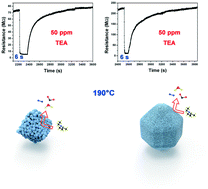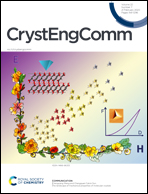Nickel/iron-based bimetallic MOF-derived nickel ferrite materials for triethylamine sensing†
Abstract
Nowadays, metal–organic framework (MOF) based oxides have been gradually regarded as promising gas-sensing materials. In this study, the small-sized NiFe2O4 polyhedrons were first synthesized through the pyrolysis of Fe/Ni-based bimetallic MOF precursors that were synthesized by ligand acid complexation. Subsequently, large-sized NFO polyhedrons with more stable morphology and structure were synthesized by changing the solvent composition. The concrete microstructure of the as-synthesized samples was characterized by means of X-ray diffraction, scanning electron microscopy, transmission electron microscopy and high-resolution transmission electron microscopy. The large-sized NFO polyhedron based sensors present satisfactory triethylamine (TEA) gas sensing performance, such as fast response speed (6 s to 50 ppm TEA), enhanced response values (18.9 to 50 ppm TEA), good selectivity and repeatability at a relatively low working temperature (190 °C). Only a few studies have reported on the use of MOF-derived NFO materials in TEA detection. Hence, our work expands the application of MOF-derived NFO materials. In addition, the sensing performance and sensing mechanism are discussed in detail.



 Please wait while we load your content...
Please wait while we load your content...